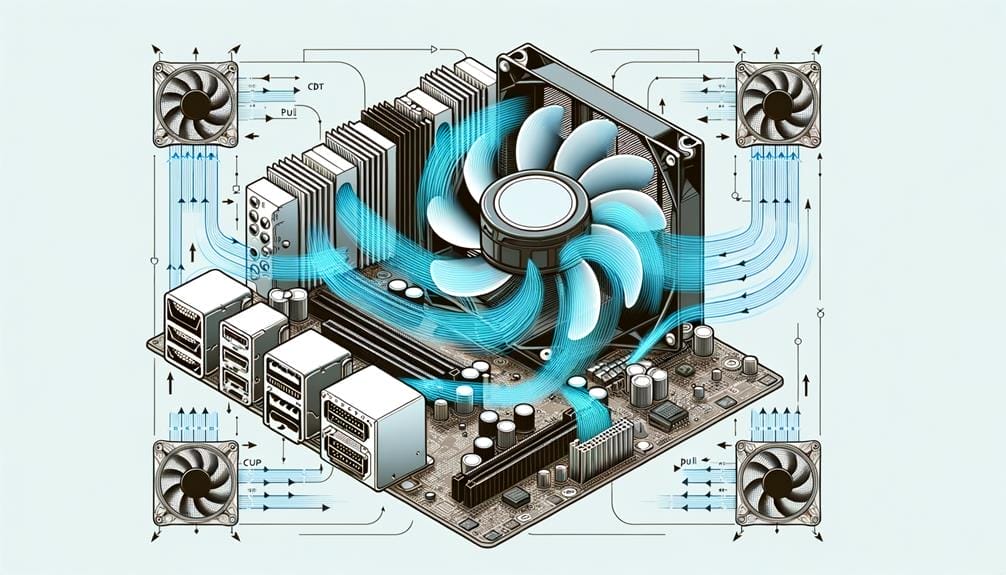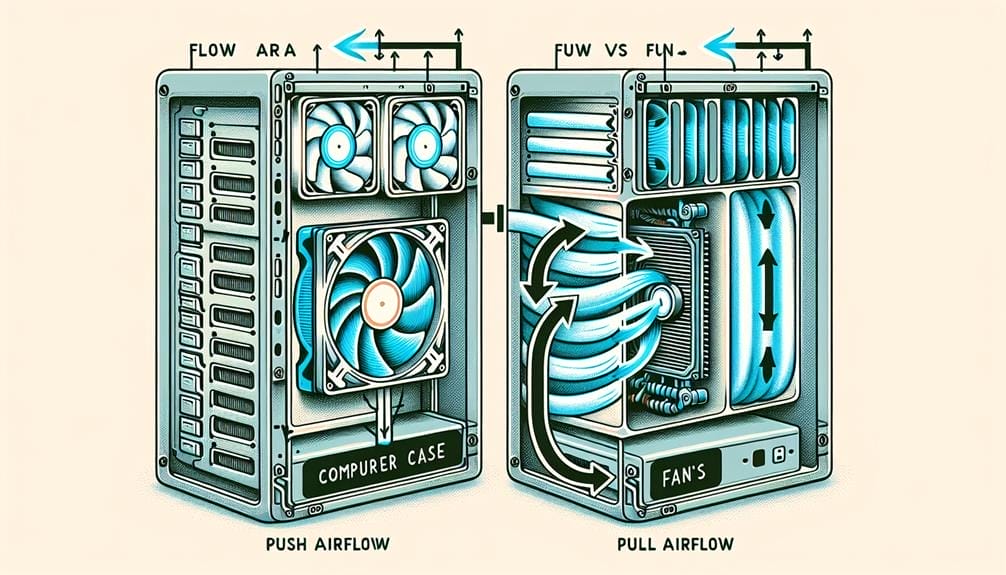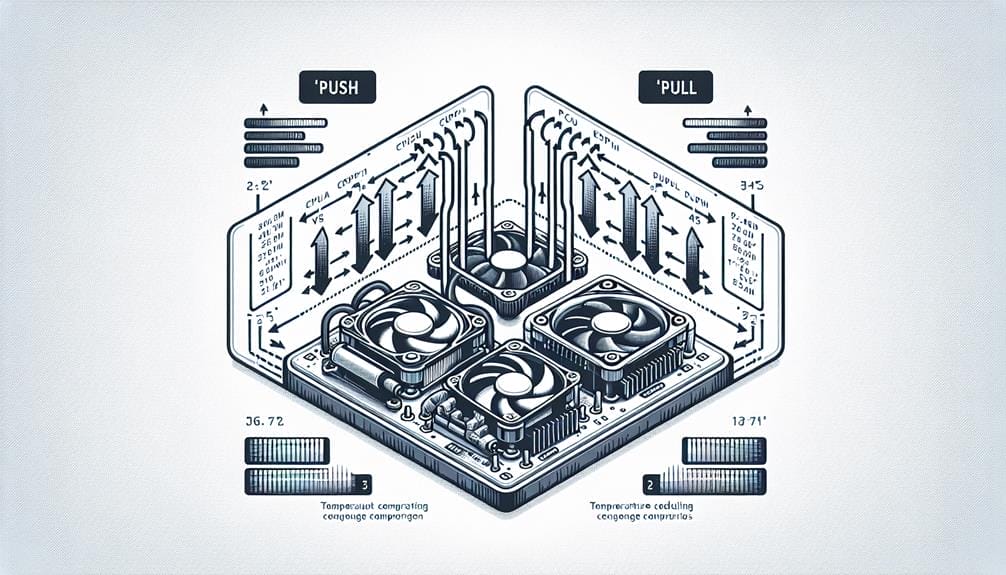Optimizing CPU Coolers: Push Versus Pull Debate

The excitement around finding the **ultimate CPU cooling method** never dies down in the ever-evolving tech jungle. As tech leaps forward and our hunger for more power grows, the quest to keep our computers chill is more crucial than ever.
The push versus pull debate is a focal point in this quest for optimal cooling solutions, and the implications of these configurations extend beyond the mere placement of fans. Understanding the intricacies of airflow dynamics and the impact of positive and negative pressure setups on overall system cooling is paramount.
As we delve into the complexities of this debate, it becomes evident that the choice between push and pull configurations holds significant implications for the overall performance and longevity of computer hardware.
Key Takeaways
- Positive pressure setup with more intake fans than exhaust fans is recommended for most PC cases.
- The push configuration for the heatsink fan is preferred for better cooling performance.
- Adding an additional fan to the CPU cooler in a push-pull configuration enhances cooling efficiency.
- Radiator fans should be mounted in a push configuration, and a push-pull configuration can further improve cooling temperatures.
Case Airflow and Fan Configurations

The optimization of case airflow and fan configurations is pivotal in maintaining efficient cooling within a PC system, with particular emphasis on achieving a positive pressure setup for superior performance. Proper airflow management ensures that components receive adequate cooling, preventing overheating and maintaining optimal performance. Additionally, the impact of airflow on overall system temperature is significant.
The importance of dust control in PC cases cannot be overstated, as it directly impacts the system's overall temperature. A positive pressure setup, with more intake fans than exhaust fans, helps in preventing dust from entering the case through unfiltered openings. It also influences the longevity of the system by reducing the accumulation of dust and debris.
Therefore, meticulous attention to case airflow and fan configurations is essential for an efficient and durable PC system.
Heatsink Fan Placement
In evaluating heatsink fan placement, the strategic positioning of the fan in a push or pull configuration significantly impacts the cooling efficiency of the CPU cooler. The push configuration offers several advantages, including improved cooling performance and the ability to move more cool air through the CPU cooler, enhancing cooling efficiency. Conversely, the pull configuration has disadvantages, as it may not be as effective as the push configuration, especially in low-profile air coolers. Even when a tall air cooler provides a pull option, the push configuration is recommended for better cooling performance. Additionally, if spacing allows, mounting two fans on the CPU cooler for a push-pull configuration can further enhance heat dissipation. A comparison of the advantages and disadvantages of push and pull configurations is presented in the table below:
| Configuration | Advantages | Disadvantages |
|---|---|---|
| Push | – Improved cooling performance | – None |
| Pull | – None | – May not be as effective as push configuration |
Adding an Additional Fan to CPU Cooler

When considering the potential enhancement of CPU cooler performance through the addition of another fan, it is essential to evaluate the available spacing and the potential benefits of a push-pull configuration for efficient heat dissipation.
Adding an extra fan to the CPU cooler can significantly improve cooling efficiency by creating a push-pull setup. This configuration allows for faster heat dissipation from the cooler, resulting in lower overall temperatures. Dual-fan cooling, particularly in bulkier air coolers or those designed for overclocking, can offer improved thermal performance.
It's important to ensure that the spacing on the cooler accommodates an additional fan and that both fans are compatible with the heatsink. Overall, the benefits of dual fan cooling in a push-pull setup can lead to more effective heat dissipation and improved thermal management for the CPU.
Radiator Fan Placement
Placement of radiator fans has a significant impact on the overall performance and efficiency of cooling systems in PC setups. When considering radiator fan placement, the choice between push and pull configurations plays a crucial role in optimizing cooling effectiveness. The table below outlines the benefits and considerations for each configuration.
| Push Configuration | Pull Configuration |
|---|---|
| Moves more air through the radiator fins | May not provide the best cooling results |
| Better cooling performance | Less effective in some scenarios |
| Optimal for efficient cooling | Considerations needed for improved performance |
When deciding on radiator fan placement, factors such as radiator fan speed, push-pull benefits, and the balance between performance and noise should be carefully evaluated to ensure the most effective cooling solution.
Fan Recommendations for Heatsinks and Radiators

For effective cooling performance and optimization of airflow, selecting a PWM fan with a compatible size and high static pressure rating is crucial for both heatsinks and radiators.
When considering fan recommendations for heatsinks and radiators, it's essential to factor in noise considerations for heatsink and radiator fans. Quieter fans should be considered for a push-pull configuration to balance performance and noise, especially when considering radiator fan placement.
Fans with high static pressure are ideal for heatsinks and radiators as they push air more forcefully through the fins, contributing to efficient cooling. It's important to choose the right fan size for heatsinks and radiators to ensure proper airflow and cooling performance.
Push Versus Pull Configuration Debate
In the ongoing debate over the optimal fan configuration for CPU coolers, the choice between push and pull setups remains a subject of technical scrutiny and practical application. When considering push versus pull performance, it is essential to weigh the pros and cons of each configuration carefully.
- Push Configuration:
- Pros: Pushes more cool air through the CPU cooler, enhancing cooling efficiency.
- Cons: May not be suitable for low-profile air coolers and can sometimes create clearance issues.
- Pull Configuration:
- Pros: Common in low-profile air coolers and can be effective in specific setups.
- Cons: May not offer the same level of cooling performance as push configuration and is less commonly preferred.
- Push-Pull Configuration:
- Pros: Can significantly enhance cooling efficiency by expelling hot air and drawing in cool air simultaneously.
- Cons: Requires additional space and may increase complexity in setup and wiring.
Optimal Fan Configurations for CPU Coolers

The selection of an appropriate fan configuration plays a critical role in optimizing the cooling performance of CPU coolers, impacting both efficiency and temperature management.
In the push-pull configuration debate, a push setup is generally preferred for improved cooling performance. This configuration moves more cool air through the CPU cooler, enhancing cooling efficiency.
Additionally, when feasible, adding an extra fan to the CPU cooler for a push-pull configuration can further improve heat dissipation.
When it comes to radiator fans, a push configuration is recommended for optimal performance, and a push-pull configuration with fans on both sides of the radiator can enhance cooling.
It's important to select PWM fans with high static pressure ratings for both heatsinks and radiators, ensuring effective air movement through the cooling components.
Conclusion
In conclusion, the debate between push and pull configurations for CPU coolers is a complex and nuanced topic that requires careful consideration of airflow dynamics, fan placement, and case pressure.
By understanding the impact of positive and negative pressure setups, as well as the advantages and considerations of push and pull configurations for heatsink fans, individuals can make informed decisions to optimize the cooling performance of their CPU systems.
Selecting the most suitable fans for heatsinks and radiators is crucial for achieving effective cooling and maintaining hardware longevity.

